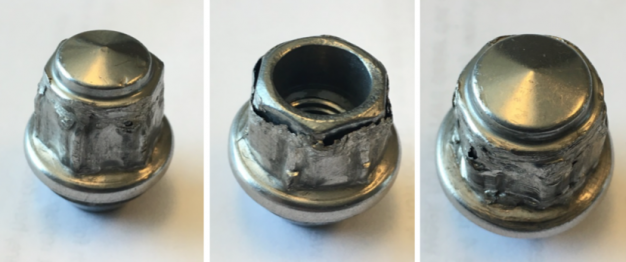Have you ever tried to change a tire, only to find that your lug nuts seem almost impossible to remove? If so, you might be dealing with swollen lug nuts.
These pesky little components can turn a simple tire change into a frustrating ordeal. But what exactly are swollen lug nuts, and why do they matter to you and your vehicle’s safety? Swollen lug nuts occur when the outer metal cap of the nut expands or deforms, making it difficult to fit a standard wrench or socket over them.
This can happen due to corrosion, heat exposure, or simply wear and tear over time. While they might seem like a minor inconvenience, swollen lug nuts can pose serious risks if not addressed properly. They can make tire changes difficult, delay roadside assistance, and even compromise the safety of your wheels. We’ll delve into the reasons behind swollen lug nuts, explore their potential dangers, and provide you with valuable tips on how to manage them effectively. By understanding the impact these tiny parts can have on your driving experience, you’ll be better equipped to keep your vehicle in top shape and ensure your safety on the road. Keep reading to discover everything you need to know about swollen lug nuts and how to tackle them head-on.

Credit: www.freep.com
Are Swollen Lug Nuts Dangerous
Swollen lug nuts occur when the metal casing expands due to rust or moisture. This makes them difficult to remove. Such swelling can lead to wheel detachment, posing a safety risk while driving.
Swollen lug nuts can be a puzzling issue for many vehicle owners. They might seem insignificant, but these seemingly small components hold significant importance. Understanding their potential risks is crucial for maintaining a safe driving experience. What Causes Lug Nuts to Swell?
Lug nuts can swell due to several factors. Let’s explore some common causes: – Corrosion: Exposure to water and road salt can lead to rust, causing them to expand. – Over-torquing: Applying too much force can deform them, making removal difficult.
– Material Expansion: Certain metals expand with heat, potentially leading to swelling. Signs of Swollen Lug Nuts Recognizing swollen lug nuts is important. Here are some indicators: – Difficulty in Removal: If they resist loosening, they might be swollen. – Visual Inspection: Bulging appearance suggests swelling.
– Mismatch with Tools: Standard tools might not fit properly. The Dangers of Swollen Lug Nuts Swollen lug nuts pose significant risks. Let’s delve into why they’re dangerous: These deformed nuts can compromise wheel security. As they swell, the fit becomes less secure, risking loosening while driving.
Such instability can lead to accidents, putting driver safety at risk. Additionally, swollen lug nuts complicate tire changes. Their removal becomes challenging, possibly requiring special tools. This delay can be frustrating, especially during emergencies. Preventing Swollen Lug Nuts How can you prevent this issue?
Consider these tips: – Regular Inspections: Check them periodically for signs of rust or deformation. – Proper Installation: Use correct torque specifications to avoid over-tightening. – Quality Materials: Opt for high-grade nuts resistant to corrosion and expansion. Understanding and addressing swollen lug nuts is vital.
It ensures vehicle safety and smooth tire maintenance. Stay informed to avoid potential hazards.

Credit: www.caranddriver.com
Conclusion
Swollen lug nuts can be a hidden danger. They may seem harmless, but they can cause problems. Imagine struggling with a flat tire. A swollen lug nut can complicate things. It’s crucial to inspect lug nuts regularly. Simple checks can prevent big issues later.
Replace any swollen nuts promptly. This ensures safety and peace of mind. Your vehicle’s health depends on these small details. Stay proactive and keep your ride smooth. Don’t ignore the signs. Swollen lug nuts are more than a minor inconvenience.
They matter.
